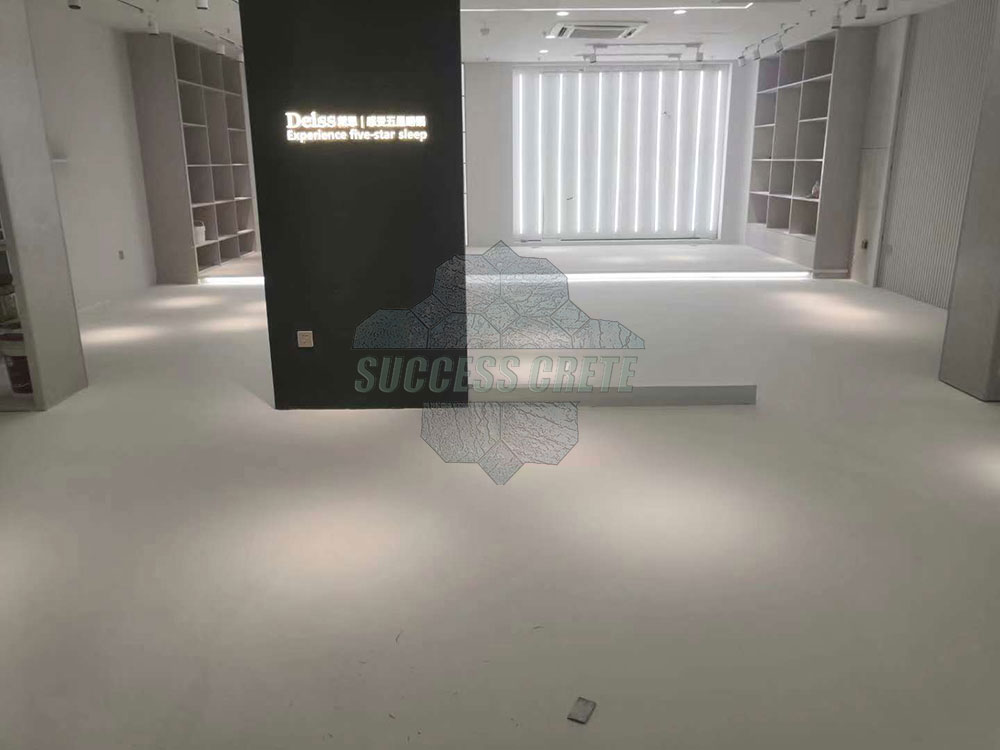Introduction
Are cement and self-leveling concrete the same?
This is a great question and one that you should consider when planning any renovations or new construction for your commercial space.
Today, we’ll dive into what self-leveling concrete is, how it compares to regular cement, and why self-leveling concrete has a larger market share. And why this material may be the perfect choice for all of your upcoming contracting projects?!
Just reading through this blog, you will get the answers.
This blog will include the following content:
- Self leveling concrete vs cement
- Reasons for preferring self leveling concrete
- How much self-leveling concrete do I need
Let’s analyze the advantages and disadvantages of Self-leveling concrete and cement, and the differences between those two, so that may better help you make a choice.

Self leveling concrete vs cement
What is Self leveling concrete?
- ·Self-leveling concrete is a cementitious mixture similar to regular concrete, but it flows easier and sets faster.
- ·It can be mixed with water, pumped or dumped into place, and spread evenly with a gauge rake.
- ·Depending on the product used, self-leveling concrete may become smooth and level within 1-2 hours.
- ·After approximately 6 hours of drying time, it may be ready for use as a bedding layer for tile, carpet, or other floor coverings.
Product name
- ·Self-Leveling Concrete is also referred to as “self-leveling underlayment”.
- ·It is a mixture of Portland cement, polymer plasticizers, and other ingredients.
- ·It has the strength of concrete but flows more easily and can be installed faster.
Pour
- ·Self-leveling concrete can be poured as thin as a quarter of an inch, or up to 5 inches thick with the addition of aggregate.
- ·It is suitable for radiant heating installations because it flows easily around pipes, whereas thicker floor leveling compounds must be troweled to achieve a proper finish.

The Advantages and disadvantages of Self-Leveling Concrete
Advantages of Self-Leveling Concrete
Easy to apply
Self-leveling concrete is an amazing building material that has many benefits.
One of the best things about self-leveling concrete is how easy it is to apply. It can be done in a few quick steps with minimal effort and without the use of tools.
Whether you are a professional or a do-it-yourselfer, self-leveling cement offers a quick, easy, inexpensive, and reliable solution.
Its no-touch lifting technology allows you to get the job done quickly and accurately with ease.
Requires less labor
It requires less labor than traditional methods. This type of concrete automatically levels itself without the need for hand smoothing, which not only saves time but also reduces the costs associated with labor.
Obtain a flat and smooth surface
Traditional concrete placement results in an uneven surface due to human error, but self-leveling concrete completely eliminates this problem.
Self-leveling concrete is an innovative, cost-effective technique that helps you achieve a smooth, level surface with minimal effort.
Self-leveling concrete is primarily used in the construction of commercial and residential buildings. Its self-leveling nature reduces labor costs, minimizes dents and bumps, and it eliminates the need to grind or smooth out imperfections.
Waterproof surface
One of the many advantages self leveling concrete provides is its ability to create a waterproof surface. If a floor needs to be water-resistant, self-leveling concrete will ensure that the job is done right.
Inhibits microbial growth
This particular type of concrete not only makes its application process smooth and easy.
In fact, self-leveling concrete has been shown to inhibit the growth of microorganisms; this means that self-leveling can be used to create a highly mold-resistant surface – perfect for areas such as bathrooms and kitchens.
Best choice for heavily reinforced concrete structures
Self-leveling concrete is becoming an increasingly popular choice for heavily reinforced concrete structures
The important point is that self-leveling concrete levels itself, without the need for leveling or any additional manual labor: is, therefore, cost and time efficient in its construction.
This makes Self leveling concrete vs cement the best choice for large flooring projects, such as pathways, driveways, pedestrian areas, and even basements, because self-leveling concrete can be applied in multiple layers.

Disadvantages of Self Leveling Concrete
- The low elasticity of ready-mix is a major disadvantage. Preparing the base and ensuring quality Fills are essential for mounting self-leveling floors.
Owners often give negative feedback as it is difficult to achieve good quality results with this type of flooring.
- The owner of this floor filler has noted that it is not ideal due to its strong odor when poured.
It is advised to leave the premises after installation in order to avoid any potential poisoning.
- The cost of the material can be high as it requires a large amount per square meter.
Special supports should be provided for this type of flooring in order to prevent breaking up over time and possible surface damage occurring as a result.

The Advantages and disadvantages of Cement
The Advantages of Cement
Widely Used
With the right mix of cement, plaster, and some H20, you can give a masonry surface an ultra-smooth finish. Not only that – it offers plenty more benefits too…
Cement is an extremely versatile product that has cemented its position as one of the most widely used materials in the world. Not only has cement been used for centuries to build strong and reliable structures, but its benefits are numerous.
Great binding strength
There is no doubt that cement has many benefits. One of its main advantages is the high bond strength – cement provides an incredibly strong bond that is used by professionals to create structures with staying power.
Cement can be used for large-scale foundations, as well as for smaller construction projects and beyond. In masonry, it is used to create a strong bond between bricks and stones.
Not only that, there are various types of cement.
One of them is Portland cement, introduced by the English manufacturer Jason Aspdin in the 19th century. This is a water-setting cement with excellent water resistance.
Cement refractory
Not only is cement strong, durable, and waterproof, but cement refractories make it stronger by providing better thermal insulation, chemical resistance, and corrosion resistance to the cement surface.
Cement refractories not only increase the shelf life of cement, but they also increase the uses of cement: cement with the benefits that cement refractories provide can be used to fireproof building products and protect materials from extreme temperatures.
Disadvantages of cement
Not environmental protection
A major drawback of cement is that it is not as environmentally friendly as some other building materials. The manufacturing process of cement releases pollutants into the atmosphere, including carbon dioxide, which contributes to global warming.
In addition, cement production exacerbates an already fragile natural environment due to the effects of vectors such as air pollution and changes in land use.
Therefore, cement is not the most environmentally friendly choice when it comes to construction or renovation projects.
Durability
Cement cannot compete with concrete in terms of durability. Cement is a common material for outdoor projects and construction, however, it does not compare to the longevity of concrete.
This is because cement does not hold itself together completely, and over time, weathering and other environmental factors cause it to break down easily and be unsuitable for construction projects. These structures are often under pressure and must be built with stronger materials.
In these cases, concrete is a more suitable choice.
Although cement is a cheaper alternative to concrete, it fails in terms of the long-term use of both materials.
Cement is of limited use for large structures
While cement works well for patio slabs and other small projects, once you start building large-scale elements, such as buildings, cement becomes too brittle to use effectively and alternative materials must be used.
For this reason, cement will never be the material of choice for bridges and other large structures. Therefore, if your next building project is larger than a basic enclosure, you may want to consider the alternative options that concrete offers.

Reasons for preferring self leveling concrete
Self-leveling concrete is becoming increasingly popular due to its many benefits.
When it comes to Self leveling concrete vs cement.
Unlike traditional concrete, self-leveling concrete requires minimal effort in terms of installation and maintenance. It can be easily poured anywhere and levels itself as it sets, which eliminates the need for additional labor and technical expertise.
In addition, self-leveling concrete creates a smooth surface and fills in any imperfections, making it ideal for laying tile or hardwood floors, thus providing a uniform base for added stability.
What’s more, the convenience and durability of self-leveling concrete make it an attractive option for homeowners and businesses.
Because self-leveling concrete lasts longer, it offers fewer maintenance issues over time.
If your next project requires fast, high-quality results that will stand the test of time, self-leveling concrete is a great choice!
How much self-leveling concrete do I need?
How thick can you lay a self-levelling compound? As self-leveling cement is used on floors with an uneven surface of 5mm or less, the result isn’t usually more than an inch thick. However, some compound variants can offer a thickness of up to 5 inches.
When it comes to self leveling concrete, the amount you need really depends on your project. You may want to use self leveling concrete to create a smooth foundation or floor in your home.
Calculating the amount of self leveling concrete needed can be tricky as it depends on the size and shape of the area that needs to be covered, as well as its depth.
For example, a smaller area such as a kitchen counter might require less self leveling concrete than a larger area such as a living room floor.
Here are examples of methods of calculating how many microcement you need to use.
Most leveling compounds are supplied as a ‘cementitious’ (cement-based) powder, ready for mixing with water.
A common bag size is 25 kg.
The coverage rate is sometimes shown in square meters per bag when spread at a particular thickness. For example, the bag might state:
Coverage: 13 m2 at 1 mm thick per bag
Alternatively, it might be expressed as the number of kilograms per square meter at a given thickness, such as:
Coverage: 2 kg/m2 at 1 mm thick
Example
Say you are going to install a cement-based leveling compound on the floor shown in this plan. The compound comes in 25 kg bags and the coverage for each bag is listed as 13 m2 at 1 mm thick per bag.
You have estimated that the average thickness required will be 3 mm. How many bags will you need?
Step 1: Find the area
In the previous lesson, we calculated the area of this floor plan as: 11.35 m2
Step 2: Find the coverage for the given thickness
The manufacturer has nominated coverage of 13 m2 for one bag (25 kg) when spread at an average thickness of 1 mm. Therefore a 1 mm thickness will require:
11.35 ÷ 13 = 0.9 bags
Step 3: Find the number of bags
Because you have estimated that your average thickness will be 3 mm, you’ll need to multiply the Step 2 figure by 3:
0.9 x 3 = 2.7 bags
If you wanted to know how many kilograms of compound this represents, simply multiply the number of bags by the kg per bag:
2.7 x 25 = 67.5 kg
However, the best way to determine the exact amount of Self leveling concrete vs cement you need for your project is to consult with a professional who has experience in this type of work.

Conclusion
When it comes to self leveling concrete vs cement, self-leveling concrete is the top choice.
Not only is self-leveling concrete incredibly easy to use – its self leveling properties mean that it can be applied with minimal effort – but self-leveling concrete also has excellent strength and durability.
With self-leveling concrete, you’re guaranteed a surface that looks perfect due to the leveled evenness created by self-leveling concrete’s unique properties.
It’s easy to see why self-leveling concrete is becoming more popular among those who are looking for a long-lasting, smooth surface finish.
Please feel free to contact us, if you have any questions or have an interest in our products.




